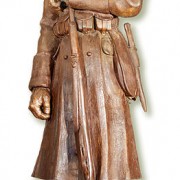Location in relation to the surroundings
The monument stands in the park opposite the municipla office. Behind the statue ia cider alley.
Text of the inscription
1914 – 1918
ADAM ONDREJ. rob. *8.III.1896. †15.II.1915. BARAN JOZEF. ‟ *9.II.1881. †24.VIII.1914. BARAN ŠTEFAN. ‟ *18.V.1870. †21.VIII.1917. BARAN ŠTEFAN. ‟ *5.IV.1887. †28.VI.1915. CABÁNIK JÁN. ‟ *30.VIII.1895. †5.IV.1915. CABÁNIK JOZEF. ‟ *9.II.1882. †17.V.1915. CABÁNIK ONDREJ. ‟ *17.VIII.1888. †29.VI.1915. GAJDOŠÍK ANTON. obuv. *17.IX.1887. †9.XII.1917. HLINKA MARTIN. rob. *19.IX.1878. †14.VIII.1916. HLINKA ŠTEFAN. rol. *18.VIII.1891. †5.IV.1916. HODŽA ARNOLD. rob. *12.V.1897. †18.V.1916. HROMÁDKA JÁN. ‟ *23.VI.1893. †2.II.1915. HUBAČ JÁN. ‟ *2.I.1885. †24.X.1914. HUBAČ ŠTEFAN. obuv. *4.XII.1891. †15.IX.1915. JÁNOŠ TOBIÁŠ. rob. *27.II.1893. †15.IX.1915. KLIMAN ONDREJ. ‟ *6.VI.1892. †8.I.1916.
KOLOREDY MARTIN. rob. *15.IX.1885. †8.V.1918. KRÁTKY JÁN. ‟ *26.6.1896. †31.III.1915. KRÁTKY ŠTEFAN. ‟ *6.XII.1891. †10.X.1916. KRÁTKY ŠTEFAN. ‟ *13.XII.1896. †20.IX.1918. KUPEC ONDREJ. ‟ *13.X.1891. †18.VIII.1915. LACLAV ONDREJ. kov. *13.I.1881. †19.VIII.1915. MAJERSKÝ ŠTEFAN. rol. *29.XI.1890. †24.III.1918. MARČOK JÁN. rob. 3.III.1895. MIHÁL JÁN. ‟ *27.XII.1881. †31.III.1917. MLYNÁRIK JÁN. ‟ *6.IV.1890. †26.XII.1914. NEMEC JOZEF. ‟ *25.I.1883. †23.IX.1915. PAULÍK JÁN. ‟ *1.III.1886. †31.III.1917. PETROVIČ IMRICH. obuv. *21.V.1872. †9.II.1915. TÖKÖLY ALEX. rob. *11.V.1876. †31.III.1915. VICIAN JOZEF. ‟ *13.III.1885. †2.V.1915.
General description
A heroic bronze statue of Austian-Hungarian army the soldier in a military coat, putees and a bent head stands on a base made of pink ryolit. A large cross with years 1914 – 1918 is in front of the soldier.
Condition
Good
The circumstances of unveiling
Relatively small village (at that time has roughly one tousand people) collected the money for a monument. The choice of the author was clear: a professor and academic sculptor born in this village, Ladislav Majerský – a well known portraitis, medal designer, author of monuments and reliefs. The sculpture was cast in Prague. The pink ryolit stone was donated by a local mine.
Later history
Originally the monument was placd at the crossroads. During the world war II the village was bombed and the monument damaged. Only in the 1970‘s it was renovated in Strojárne Vyhne and moved to it actual place due to the alteration in the traffic.
Contemporary importance
The monument is unique in Slovak context due to its expresionist style. Nowadays a commemorative events take place here with laying wreaths and flowers.
Publications, sources, links




















